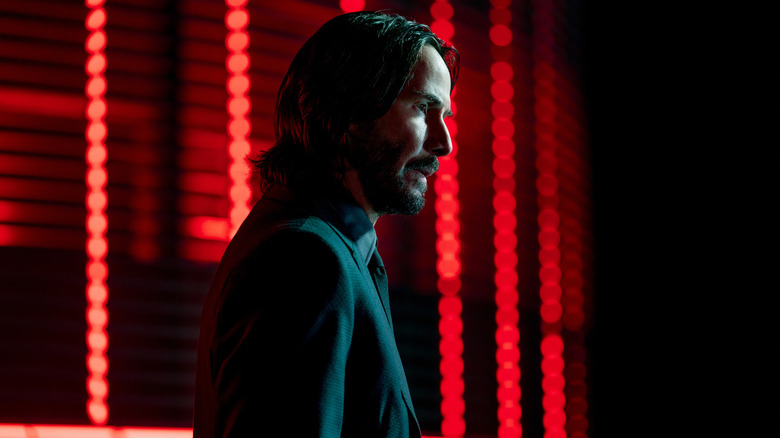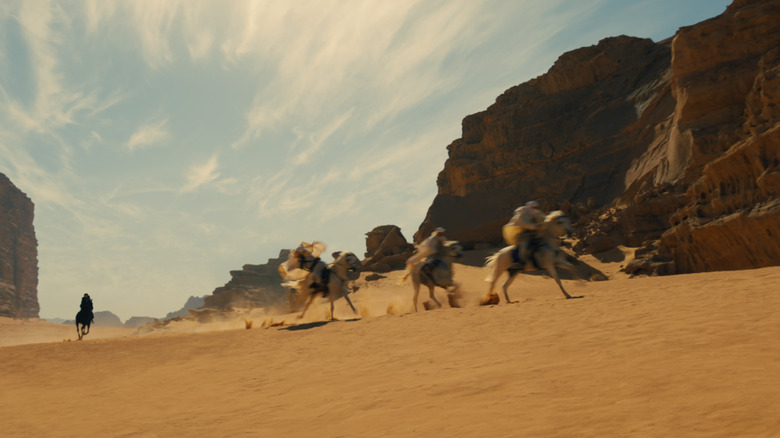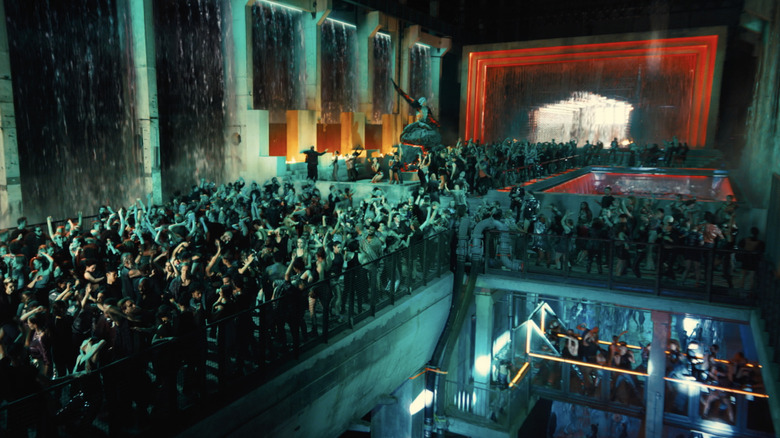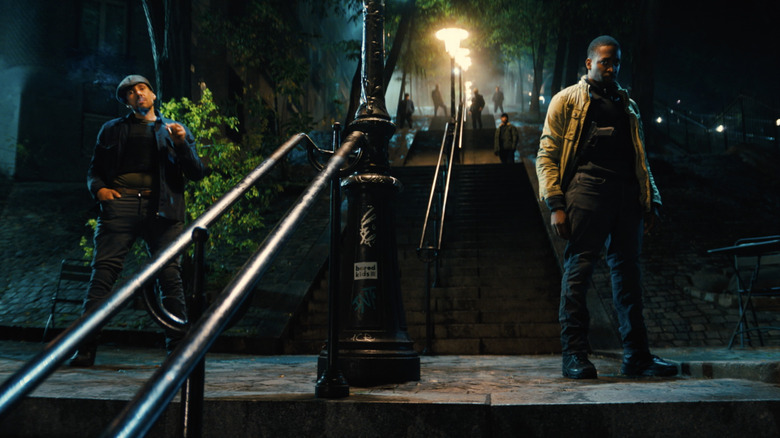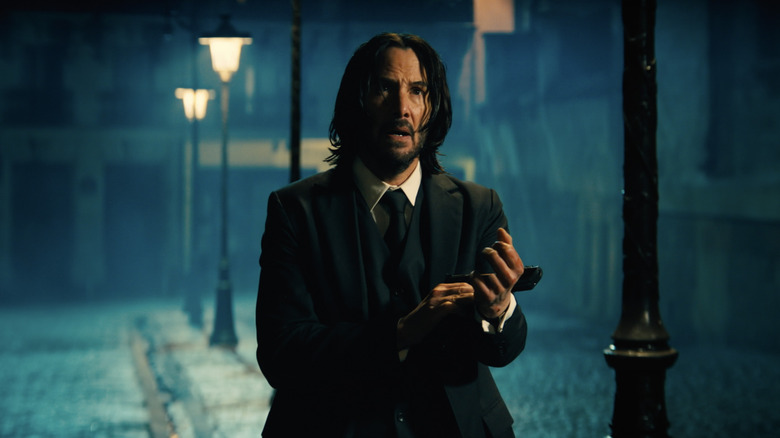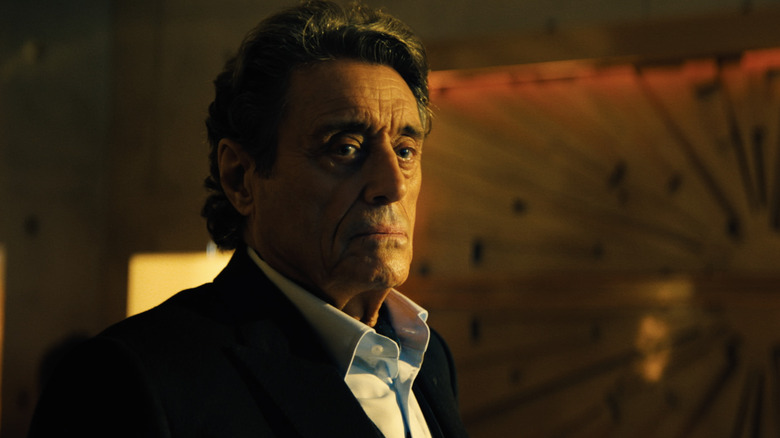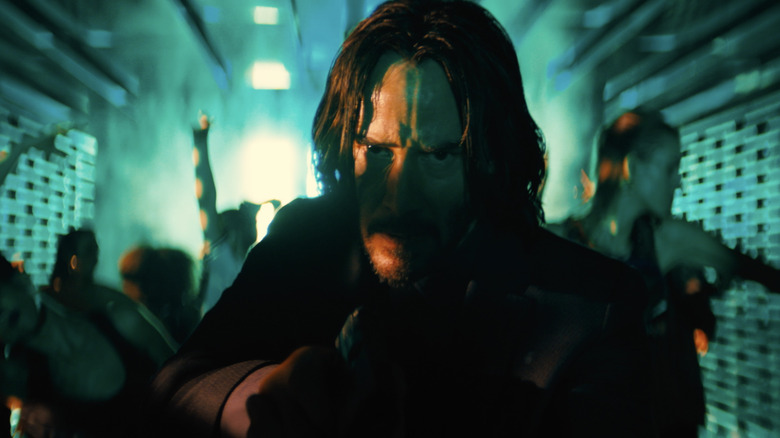John Wick: Chapter 4 Ending Explained: Be Seeing You
This article contains massive spoilers for "John Wick: Chapter 4."
There's an ancient saying: "Before you set out on revenge, first dig two graves." The axiom has been attributed to everyone from Confucius to James Bond, but while its origins are indeterminate, its sentiment is evergreen. Revenge is a deadly business that will likely consume the soul — if not the life — of anyone who seeks it.
John Wick (played with brooding soulfulness by Keanu Reeves) can attest to the truth of that saying, as can many of his friends and enemies. In the latest (and, could it be, final?) installment of his saga, "John Wick: Chapter 4," the daughter of Wick's friend Shimazu (Hiroyuki Sanada), Akira (Rina Sawayama), observes that "everything he touches, dies." Another of Wick's on-again, off-again allies, Winston (Ian McShane) pleads with John to know where his roaring rampage of revenge will end. John himself, as ever, isn't sure of the particulars.
Although he can't speak to where or when it will end, he knows how and why. In the world of "John Wick," the members of and those under the criminal organization The High Table are essentially trapped, hamstrung by their long-held traditions of rules all while their belief in decorum and honor blind them to their baser natures as well as their horrendous deeds.
Wick, a man who once escaped this world to lead a "normal" life with his doomed wife, Helen (Bridget Moynahan), has the unique perspective of both an insider and outsider. The long, nearly endless string of injustices done to him and done by him needs to be accounted for, and justice, not the Table, is what must be served. In "Chapter 4," the scales finally start to balance.
A classic Epic
With "Chapter 4," director Chad Stahelski along with writers Shay Hatten and Michael Finch have brought back the Action Epic in a big way: the only thing cooler than the film's world-spanning over its 169-minute runtime would be an intermission.
Stahelski announces this classic epic intention right away: John, who's been training and healing in the bowels of New York City at the behest of The Bowery King (Lawrence Fishburne) ever since their betrayal in "John Wick: Chapter 3: Parabellum" by the High Table's machinations, is sent to Morocco as the King blows out a lit match, the hard cut to the desert a knowing wink to the similar moment in David Lean's "Lawrence of Arabia."
Upon finding a new Elder (George Georgiou) in place of the one in "Parabellum," John is warned that any revenge he takes will be futile, as the Table cannot be fully destroyed due to the bevy of replacements waiting in the wings. John assassinates him anyway and then flees to the Osaka Continental where he is sheltered by Shimazu. Sure enough, a new threat in the form of High Table member, the Marquis Vincent de Gramont (Bill Skarsgård), sends an army of goons to raze the hotel shortly after destroying NYC's Continental and murdering Winston's compatriot, Charon (Lance Reddick) in front of him.
While Wick fights to escape Japan, he discovers that back in Paris, the Marquis had hired his old pal, Caine (Donnie Yen), to hunt him down and kill him. Although blind, Caine is a formidable foe, and John barely escapes with his life thanks to Mr. Nobody (Shamier Anderson), a Tracker looking to raise the bounty on Wick's head. Unfortunately, Shimazu is not so lucky, struck down by Caine while Akira watches.
Down the rabbit hole (or: the Demon Way into Hades)
Meeting up with Winston at Charon's grave, the former hotel manager informs Wick that the assassin could buy his freedom from the Table (as well as reinstate Winston to managerial status) by challenging the Marquis to a duel. In order for that to happen, he must be backed by a family with a seat at the Table. So, John travels to Berlin to speak to Katia (Natalia Tena), the new head of the Ruska Roma family which John (once known as Jardani Jovanovich) used to belong to before being excommunicated.
Katia informs John that she will only bring him back into the family's fold if he murders the man responsible for her father's death, a German Table member known as Killa (Scott Adkins). John, Caine, and Mr. Nobody converge at Killa's club, and all hell breaks loose. Almost literally: the club is designed, shot, and staged to resemble a Hieronymus Bosch-style painting of Hell, a realm that Wick must once again survive through and escape.
This structure — to the film and the "John Wick" series in general — is very much intentional. Stahelski has gone on record as being inspired by Greek mythology, with John being analogous to the mythological figures of Odysseus (fighting for his wife), Sisyphus (two steps forward, three back), and Orpheus (emerging from Hell, as in the film's opening scene) in particular. Add to that the way the "Wick" films riff on the rich history of action cinema, from Epics to low-budget features and everything in between, both domestically and abroad. John's plight is similar to that of Ogami Ittō, the disgraced and excommunicated warrior of the "Lone Wolf and Cub" series (both the manga and the motion picture adaptations) who travels the "demon way in hell," constantly having to fight for his life while seeking vengeance.
Bop so hard MF'ers wanna find me
The "Wick" films also resemble the journey of Alice in Lewis Carroll's "Alice's Adventures in Wonderland" and its many adaptations. Ever since his fateful decision to "dip a pinky" back into the underworld as Winston once put it, John has, like Alice, seemingly fallen further into an alternate reality that feels inescapable. As his journey continues, he discovers that freedom is what he truly desires above all else.
Having finally assassinated Killa and regained acceptance from the Ruska Roma, John makes his challenge to the Marquis, and the two discuss terms of the duel that are adjudicated by the Harbinger (Clancy Brown). The duel will take place with pistols at sunrise, on the Parisian home turf of the Marquis, at the Sacré-Cœur.
However, the Marquis has no intention of letting the duel ever commence. Overnight, he issues an order to all the assassins (or "boppers," if you will) of Paris via a radio DJ (Marie-Pierra Kakoma) to kill Wick before dawn. John must then fight his way through a series of killers while attempting to reach his destination, an extended sequence that's almost like a complete action film all by itself, touching upon such disparate influences as Walter Hill's "The Warriors," the video game "The Hong Kong Massacre," Steven Spielberg's "Minority Report," and the Greek myth of Sisyphus.
Fortunately, Wick is helped during the final stretch of his gauntlet by two unlikely allies: Caine and Mr. Nobody, the former out of deep friendship, the latter thanks to Wick saving the life of his dog from one of the Marquis' lieutenants.
Barry Lyndon's Degüello
Given all of the escalation in scope and action that the "John Wick" films have enjoyed over their four chapters, it's fitting and clever that it all boils down to a relatively simple duel. Relatively, that is because both John and the Marquis attempt to bend the rules of the game for their own ends. The Marquis chooses Caine to act as his proxy, stacking the deck by telling Caine that his daughter will have her safety guaranteed if he accepts.
In a nod to Stanley Kubrick's "Barry Lyndon," the duel is conducted with its decorum masking ulterior motives beneath, and in a simultaneous allusion to Sergio Leone's "Dollars" trilogy, the score by Tyler Bates and Joel J. Richard assumes the mode of a Mexican Degüello, a bugle-led style appropriated by Ennio Morricone for the trilogy's iconic showdown moments. Just like "For a Few Dollars More," all the principal players of "Chapter 4" are present during this moment, with Mr. Nobody nervously looking on as the duel commences.
Caine gets in two fatal shots, causing an exhausted and wounded Wick to fall to the ground. Leaping at the chance to administer the "coup de grace" and deliver the final bullet into Wick's head, the Marquis takes over for Caine, only for Winston to point out that, as per the rules, a still-breathing Wick is owed a turn for the shot he has yet to fire. Wick obliges, nailing the Marquis directly between the eyes.
The dawn of a Neo day
Throughout "Chapter 4," the characters of the film ruminate on death, far more often than those who are constantly surrounded by it usually do. Winston recounts the tale of bushranger Ned Kelly's calm acceptance of his fate, Charon and Shimazu die with dignity and loyalty, Killa foolishly assumes he has immortality, and John, Winston, and the Bowery King discuss their own epitaphs. During this conversation, John declares what he wants on his tombstone: "Loving Husband."
The choice is indicative of John's true desire: to again regain his freedom from the Hell of the underworld and become John, husband of Helen, instead of the "Baba Yaga," John Wick. Upon defeating the Marquis, John is granted this wish by the Harbinger. A wounded but living Caine makes amends with John, and Mr. Nobody (along with his puppy) lives to see another day. Winston promises to take John home, the latter knowing he's facing his imminent end.
Yet despite the fact that the High Table's reign continues anon with new faces replacing those removed, John is free, the scales of justice having been balanced by the vengeful spirit known as John Wick. "John" enjoys his final moments on Earth, his fate almost predetermined: when we met this man in "John Wick," he was already a shell of a person, Helen's death having robbed him of his higher purpose in life. He lived just long enough for the spirit of revenge to possess him and collect what was owed, even though he knew it would mean that a second grave would be dug.
As John enjoys the sun on his face, it's a moment reminiscent of the film trilogy that Reeves and Stahelski first collaborated on: the finale of "The Matrix Revolutions," which sees a similar dawning of a new day thanks to a sacrifice, a reboot of the world rather than a full, apocalyptic deletion.
A farewell, a promise, a threat
John's story ends where it began, with an echo of the series' succinct phrase to sum up the rules and morality of its world: "Be seeing you." Although we see Winston and The Bowery King reminiscing over Wick's grave (placed next to Helen's, with his preferred epitaph on it), the layered meaning of the phrase speaks to John's potential resurrection in a future film if the movie gods will it to be so. "Be seeing you" can be issued as a final farewell, and it can also be an ellipsis, a promise for one's return.
Its other meaning is far more sinister: a threat, one which would cause anybody living in a world of assassins to watch their back. Caine might do well to keep that threat in mind, given the Achilles heel of his daughter (indicated by a musical locket that he keeps with him at all times, another sly nod to Leone's "For a Few Dollars More"). In a post-credits scene, we see the blind man begin to approach his now-safe daughter with a bouquet of flowers, only for Akira to emerge from the crowd, headed right toward Caine with a blade in her hand.
While this moment may be picked up in a future spin-off of the "John Wick" films, another chapter proper or not at all, its message is clear. The world of "John Wick" is a hellish trap, the world's worst game of "If You Give a Mouse a Cookie," one where the rules and acts of revenge will likely never allow peace or justice to be fully achieved. The only escape is the one John has made for himself, and whether there's an afterlife or not, whether John has secretly faked his death or not, at least the freedom of oblivion is unequivocally real.
